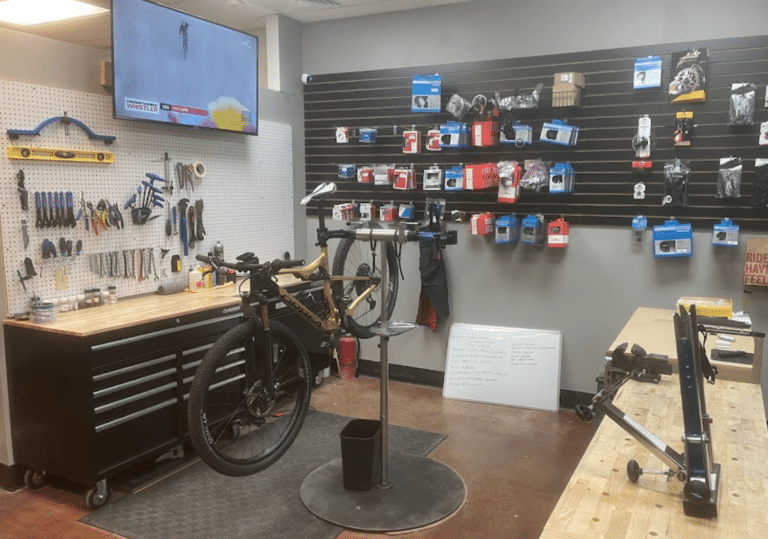It’s always exciting when winter starts winding down. The sun stays out longer, the weather warms, and the trails thaw. Soon, you’ll be ripping your favorite runs, and all will be right with the world. Before you get too excited though, go take a look at your bike. Sure, you might be ready to ride, but is your bike up for the task? It’s just been hanging out all winter after a full season of hard riding, slowly falling out of alignment. Your bike isn’t ready for the mountain, but a quick after-winter tune up will change that.
Tune Up Your Bike After Winter in 7 Steps
If you want to know how to tune up a bike after winter, the first step is learning…the steps:
-
-
- Clean and Degrease the Bike
- Inspect and Inflate Tires
- Check and Lubricate the Chain
- Inspect and Adjust Brakes
- Check Gears and Derailleurs
- Inspect and service Suspension
- Tighten Bolts and Check Frame
-
Step One: Clean and Degrease the Bike
After a hard season of riding and having sat all winter, your bike has likely accumulated dirt, grime, and possibly rust buildup from storage. A good cleaning is the first step in getting it back into peak condition. Start by using a mild degreaser for the drivetrain components (chain, cassette, derailleurs) to remove any buildup. Be sure to dry the bike thoroughly to avoid lingering moisture.
| Difficulty | What to Keep in Mind |
|---|---|
| 🟢 2/5 | It’s a simple process, but one that can take some time. |
Step Two: Inspect and Inflate Tires
Cold temperatures cause air molecules to contract, lowering tire pressure. If left unchecked, this could cause cracks in the rubber or damage to the sidewalls. Start by checking for cracks, dry rot, or worn tread. Inflate your tires to the recommended PSI—this is usually printed on the sidewall. Once inflated, spin the wheels to ensure they’re true (not wobbling).
Most mountain bikes these days are tubeless. Over the wintertime, the tubeless goo solidifies and or dries up. It is recommended that you replace the tire sealant every spring to ensure you don’t flat on your first ride. We recommend you take the old sealant out, but you may need to reinflate your tires with an air compressor if you do this. The alternative would be to remove the valve core and squeeze in new sealant.
| Difficulty | What to Keep in Mind |
|---|---|
| 🟢 2/5 | Easy to do and essential for safety and comfort on the trails. |
Step Three: Check and Lubricate the Chain
The cold can cause chain lubricants to thicken or dry out, leading to rust and stiff links. Inspect your chain for any signs of rust or stiffness. Clean it using a chain cleaner and apply fresh lubricant. Be sure to wipe off any excess lubricant, as it can attract dirt and grime over time. If the chain is worn, consider replacing it using a chain wear indicator tool.
| Difficulty | What to Keep in Mind |
|---|---|
| 🟢 1/5 | A simple but important task that improves longevity of your bike's drivetrain. |
Step Four: Inspect and Adjust Brakes
After a season of mountain biking your brake pads probably need to be replaced. Start by checking brake pads for wear. If they’re too thin or uneven, replace them. Test the brakes to make sure they’re responsive—if they feel spongy or unresponsive, you may need to bleed them.
| Difficulty | What to Keep in Mind |
|---|---|
| 🟡 3/5 | If you're unsure, it might be worth taking the bike to a shop for brake bleeding. |
Step Five: Check Gears and Derailleurs
Temperature fluctuations during winter can cause cables to stiffen and derailleurs to misalign, making gear shifting rough. Shift through all the gears and check for smooth transitions. Adjust the derailleur limit screws and cable tension if needed. Clean and lubricate the derailleur for optimal shifting performance.
| Difficulty | What to Keep in Mind |
|---|---|
| 🟡 3/5 | This step requires some knowledge of how a derailleur works and may take a bit of patience to get everything dialed in perfectly. |
Step Six: Inspect and Service Suspension
Cold weather can cause suspension seals to shrink and the fluid to become sluggish. Inspect the suspension for leaks and worn seals, and adjust the settings for your weight and riding style. If needed, consider having the suspension serviced at a professional shop to ensure everything’s functioning as it should. We recommend servicing suspension every year to ensure a smooth ride.
| Difficulty | What to Keep in Mind |
|---|---|
| 🔴 5/5 | Suspension can be more complex, and some issues may require a professional. |
Step Seven: Tighten Bolts and Check Frame
Go over the bike and tighten bolts on the handlebars, saddle, pedals, and anywhere else that needs adjustment. Also, check the frame for cracks or any signs of damage.
| Difficulty | What to Keep in Mind |
|---|---|
| 🟢 1/5 | A quick but important check to make sure everything is secure before you ride. |

Get a Professional Bike Tune at Base Camp Cyclery
Tuning up your mountain bike is essential to ensure it runs smoothly, and whether you’re prepping for a new season or maintaining your ride throughout the year, Base Camp is here to help. Known for its helpful staff, no-pressure environment, quality products, and world-class MTB services, Base Camp is a leader among local bike shops. Whether you’re looking for a quick tune-up, expert repairs, or need to find your next ride, you can count on Base Camp to give you the personalized attention you deserve.
Ready to get your bike dialed in? Head over to Base Camp, and we’ll have it running like new.

